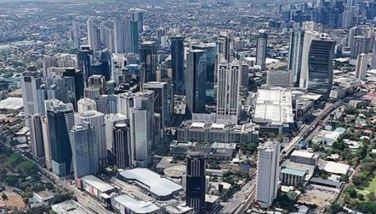POGO ban causes dip in office occupancy
Overall vacancy of prime and grade A offices in Metro Manila was estimated at 15.2 percent by the second quarter this year, posting a 129-basis-point decrease from the reported vacancy rate of 16.5 percent in the previous quarter, according to the latest report of Cushman & Wakefield, a leading global real estate firm.
Additionally, this figure is 167 bps lower than the reported vacancy rate of 16.9 percent in the same quarter of the previous year.
By end of the second quarter this year, the CWK report said, an additional 113,000 square meters of prime and grade A developments had been added to the supply, bringing the total stock to 9.65 million sqm. This, in turn, results in a quarterly net absorption figure of roughly 203,000 sqm.
The total stock is expected to increase by another 0.38 million sqm by the end of this year, although completion delays are imminent. Vacancy rates will remain elevated in the medium term due to the large volume of new office space and the effects of the deferred expansion decisions of IT-BPM companies awaiting the finalization of the amendments to the CREATE MORE Bill.
Rent remains steady
Despite the improvement in vacancy rates of prime and grade A developments in Metro Manila, the average asking rent remains steady at P1,012 per sqm per month. In the near- to medium-term, developments in the major central business districts or CBDs are expected to keep their headline rent steady, while those in the fringe areas are most likely to post lowered headline rents as high building and market vacancies persist.
Tetet Castro, director and head of the tenant advisory group at CWK, said, “Metro Manila’s commercial real estate market remains in the recovery phase in the second quarter. The overall vacancy rate decreased to 15.40 percent from the reported rate of 16.5 percent in the previous quarter. On the other hand, the average asking rent remains steady at P1,010 per sqm per month as high market and building vacancies prevail.
Overall vacancy rates will remain elevated in the medium term due to the huge volume of upcoming developments, delayed passing of amendments to the CREATE Bill and the pronounced total ban on Philippine Offshore Gaming Operators (POGOs) from the country. Nonetheless, headline rents of developments, particularly in the major CBDs, will remain unchanged.”
IT-BPM companies are now showing heightened demand for office spaces in Tier 2 locations to access the talent pool in the provincial areas and lower capital and operating expenditures. New entrants are still looking at Metro Manila to establish their first office in the country, while existing IT-BPM occupiers now consider Tier 2 locations as primary areas to expand their operations.
Serviced offices continue as an alternative to traditional office spaces. Serviced offices provide companies the flexibility they need in adjusting their space requirement to suit their current headcount, as well as their future growth projections.
Additionally, serviced offices - having no capex- make them a viable option for companies, particularly new entrants to the country.
According to Claro Cordero, director and head of research, consulting and advisory services at CWK, “Until the directive to completely ban offshore gaming operations in the country by the end of 2024 has been made official, the establishment of internet gaming licensees is seen to provide a reprieve to the current market uncertainties created by the policy pronouncement. In the long term, the complete banning of offshore gaming operations will add further downward pressure on rents due to the elevated office market vacancy rate.”
Tamed residential price growth
As demand tilts toward the prime office developments, cautious investor behavior and the challenges posed by hybrid work and altered real estate occupancy demand provide the market some time to absorb available supply, exerting further pressure on vacancies, especially in areas outside the major central business districts.
Cordero noted that “An observed pullback in discretionary expenditure persists against a weakening global economic backdrop and rising cost-of-living pressure which paint a picture of a more challenging landscape for retail space, a first after seeing the effects of revenge spending right after the extended lockdown period. Meanwhile, new retail space supply is expected at around 177,000 sqm in gross floor area for this year, significantly below the recorded 443,333 sqm delivered last year with the completion of projects previously stalled at the height of the pandemic.”
He elaborated that “Evolving consumer behavior trends, partly attributable to the shifting demographics as more Gen Z join the workforce, will continue to reinforce the growth of the digital economy. This presents an opportune time to encourage retailers to leverage the burgeoning e-commerce industry and integrate their last-mile delivery operations into existing retail space,” Cordero said.
Meanwhile, buoyed by urban decentralization efforts, changes in lifestyle and consumption habits, and the rising prominence of online grocery shopping, among other factors, the growth of the cold storage industry has accelerated in recent years with recent expansions of new, modern developments to serve the increased demand. While it has attracted a pool of property developers, with a growth target set at around eight to 10 percent annually, impediments to growth include the associated power costs and suitable digital infrastructure for automation.
The report also noted as significant the pushback against the reduction of the benchmark interest rate, which would result in a relatively tamed residential price growth. This anemic capital value growth, especially for the middle-income market, will be more highlighted due to increased levels of new and existing supply on the market and constrained demand attributable to affordability pressures.
Overall industry outlook is nuanced
CWK Research estimates gross rental yields for the Manila market will continue their upward movement in the near term as interest rates have yet to make significant downward movements.
According to Cordero, “Despite the Philippine peso being the worst-performing currency and headline inflation spiking toward the tail end of the second quarter, the off-cycle reduction in short-term interest rates by the BSP will positively impact demand growth for key property segments in the Philippine property market. The decrease in key policy rates will foster more positive forward-looking expectations of more significant reductions and set a more positive investor mindset, allowing more unlocked investment deals in the medium term.”
Furthermore, he continued, “Given the varying degrees of geopolitical, climate and interest rate risks present in the Philippine property market, the long-expected return to the recovery track is at bay for an extended period. While most asset types have exhibited healthy growth of demand drivers, the overall industry outlook is nuanced due to various market headwinds.”
Cushman & Wakefield is a leading global commercial real estate services firm for property owners and occupiers with approximately 52,000 employees in nearly 400 offices and 60 countries.
- Latest
- Trending

























